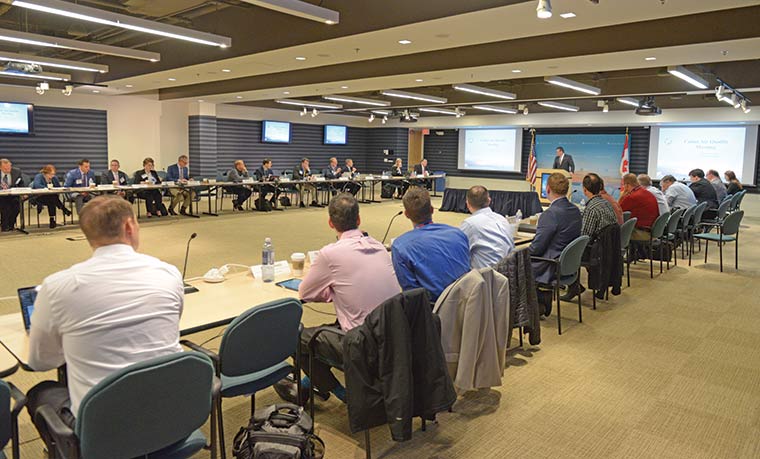Health and Environment Working Group Takes on Cabin Air Quality
By John Perkinson, Senior Staff Writer

Nearly 30 pilots from 15 airlines, plus staff from throughout the Association, assemble for ALPA’s Cabin Air Quality meeting in February.
As awareness rises around the issue of contaminated cabin air or “fume events” in flight, the level of reporting has increased. As a result, last year the FAA acted by issuing Safety Alert for Operators 18003, acknowledging growing concerns about airliner cabin air contamination. Drawn from aircraft engines, hot compressed air is cooled and channeled into the cabin to provide breathable air, also known as bleed air. The growing number of reports of contaminated bleed air have raised concerns about exposure to potentially hazardous chemicals like engine oil, hydraulic and anti-icing fluids, and other toxic compounds.
Keenly aware of these and other potential aircraft-related health concerns, ALPA’s Board of Directors has instructed the Association to “provide resources and advocate for the highest levels of safety and oversight of all ALPA pilots’ onboard environmental working conditions [e.g., potable water, air quality, radiation, cleanliness].”
This objective is part of the Association’s goal to “attain the safest and most secure air transportation system for flight crew, passengers, and cargo.” As a result, the Pilot Assistance structure of ALPA’s Air Safety Organization (ASO) recently formed the Health and Environment Working Group (HEWG).
Born in part from an ALPA Cabin Air Quality meeting this past February, HEWG met for the first time on September 9 to review its mission and make plans moving forward. Led by F/O John Taylor (United), ALPA’s Pilot Assistance chair; Capt. Steve Jangelis (Delta), ALPA’s Aviation Safety chair; and F/O Ellen Brinks (Delta), ALPA’s Aeromedical Group chair, the group developed an initial strategy for assessing cabin-air-quality events, building awareness of these occurrences, and identifying best practices and workable solutions.
“We need to find the optimum way to detect these conditions and utilize better filtration systems or other approaches to avoid a potential health or safety risk,” said Taylor. Airliners are currently not equipped with cabin-air-quality sensors to detect contamination. He noted that in some cases contaminated air is odorless and that it could potentially incapacitate flightcrew members without their awareness.
In July 2018, an airliner flying from Washington, D.C., to Los Angeles, Calif., diverted to Kansas City, Mo., because flight attendants reported that passengers were becoming ill. Flightcrew members also experienced nausea and scratchy throats. In May this year, another airliner scheduled to fly to Denver, Colo., returned to Los Angeles after fumes were reported in both the cockpit and the cabin. In each case, passengers were hospitalized. While instances of cabin air contamination may not be reported daily, the fact that they occur at all raises serious concerns.
Yet some aviation industry stakeholders have attempted to dismiss the link between cabin air quality and health concerns. And the Centers for Disease Control and Prevention has noted, “If you are exposed to a potential cabin air hazard and have health problems, it may not be possible to tell if it was caused by your work conditions or if it was caused by something else.” However, Taylor responded, “Symptoms identified by flight crews that have experienced these events are consistent with exposure to the products that can contaminate air supply systems.” And evidence is mounting, compelling lawmakers and regulators to intercede.
In addition to collaborating with other ASO groups, HEWG is also working closely with ALPA’s Government Affairs Department to advocate for the passage of the Cabin Air Safety Act of 2019 (S. 1112/H.R. 2208). Although its purpose is multifaceted, the focus of this legislation is to “improve the safety of the air supply on commercial aircraft.”
The Pilot Assistance Group encourages ALPA members to review ALPA's Fume Exposure Guidance for more on how to respond to exposure to contaminated bleed air and nonvisible gaseous fumes or odors. In addition to contacting the ALPA Worldwide Accident/Serious Incident Hotline at 202-797-4180 and ALPA’s Aeromedical Office at 303-341-4435, flight crews are urged to complete the International Air Transport Association’s Smoke and Fumes Reporting Form, which can be accessed from ALPA’s website.
“We also encourage you to fill out an ASAP [Aviation Safety Action Program] report in addition to any other reporting your airline may require,” Taylor remarked, acknowledging the importance of being able to track the number and severity of these incidents to better understand what’s happening.

